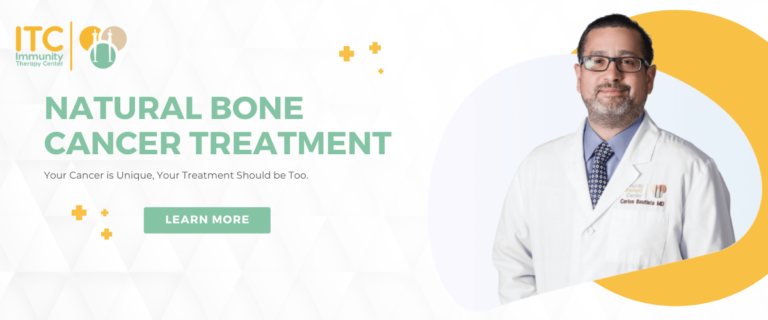First published: Nov 4, 2021
The journey through a bone cancer diagnosis is a path lined with uncertainty, fear, and questions. At Immunity Therapy Center, we understand that hearing the words “bone cancer” can feel overwhelming, especially after diagnosis.
A bone cancer diagnosis comes with questions, uncertainty, and the deep hope for healing. That’s why we be
lieve in clear information, compassionate guidance, and alternative therapies that focus on strengthening, not weakening your body. Below, we’ll explain what bone cancer is, survival rates, stages, and how holistic treatments can support you at every step.
What Is Bone Cancer?
Bone cancer isn’t a single disease. It refers to various types of tumors that begin in the bone itself. Unlike bone metastasis (when cancer spreads to the bones from other organs like the breast or lungs), primary bone cancer originates directly in the bones. Though rare compared to other cancers, it’s serious and requires timely diagnosis and treatment.
What Are the Types of Bone Cancer?
Different types of bone cancer affect patients differently, each requiring its own treatment approach. The most common types include:
- Osteosarcoma – This is the most common type of primary bone cancer. It typically starts in the long bones of the legs or arms, but it can also occur in other bones, such as the pelvis or ribs. It grows rapidly and often appears in teenagers and young adults. It can cause pain, swelling, and a lump in the affected area.
- Chondrosarcoma – This type of cancer starts in cartilage cells, which make up the flexible parts of bones. Found mostly in adults, chondrosarcoma is most common in the pelvis, shoulder, and thigh bones. It also tends to grow more slowly than osteosarcoma. However, it can still be a serious cancer if it is not treated.
- Ewing sarcoma – More common in children and young adults, Ewing sarcoma can develop in any bones or soft tissue. It’s often characterized by pain, swelling, and a fever. It’s also known to spread quickly and can affect other body parts, such as the lungs and bone marrow.
Other Types of Bone Cancer
In addition to these three main types, there are also a number of other, rarer types of bone cancer. These include:
- Fibrosarcoma – This type of cancer starts in the fibrous tissue surrounding bones.
- Malignant fibrous histiocytoma – This type of cancer is a rare type of sarcoma that can occur in any tissue, including bone.
- Giant cell tumor of bone – This type of bone tumor is not technically cancer, but it can cause bone destruction and pain.
Understanding the type of bone tumor helps guide your care plan, from surgery to immune-focused therapies.
What Are the Stages of Bone Cancer?
Staging describes how far the cancer has spread. The cancer stage plays a major role in prognosis and treatment decisions:
- Stage 1 – Cancer is localized to the bone.
- Stage 2 – The tumor may be larger but still hasn’t spread.
- Stage 3 – Cancer may involve multiple areas within the same bone.
- Stage 4 (Metastatic Bone Cancer) – Cancer has spread to other organs or distant bones. This is considered advanced or metastatic cancer.
At ITC, we remind patients that Stage 4 bone cancer is not the end of the road. With personalized, non-toxic therapies, your body still has the potential to fight back.
What Are the Survival Rates for Bone Cancer?
Survival rates for bone cancer are often expressed as percentages, giving people a general idea of how likely they are to survive the disease. However, it is important to remember that these rates are just averages and that individual outcomes can vary widely. Many patients exceed expectations with early detection and supportive treatment.
Here are the general 5-year survival rates from the American Cancer Society:
- Localized bone cancer – 77% relative survival rate. When cancer is localized in a cancer patient, it means that there is no indication that it has spread beyond the primary cancer site where it developed.
- Regional bone cancer (spread to nearby tissues) – 64% relative survival rate. Regional means that it has spread beyond the affected bone and affected other bones or structures, or has spread to nearby lymph nodes.
- Distant metastatic bone cancer – 27% relative survival rate. Distant refers to metastatic cancer that has spread to other bones in other parts of the body or distant parts of the body like the lungs. Bone metastasis cancer is usually considered one of the later stages of this disease.
The life expectancy of bone cancer patients varies depending on the exact bone cancer type and the prognosis for the disease. Whether you have bone metastasis or the stage of cancer can also affect your overall prognosis.
What Factors Affect Bone Cancer Prognosis?
The prognosis for bone cancer is influenced by a number of factors, including how fast the cancer has spread, the patient’s age and overall health, and the response to treatment. However, there are other factors that can also play a role, such as:
- Cancer type – The type of bone cancer can have a significant impact on survival rates. For example, osteosarcoma has a 5-year survival rate of about 60%, while Ewing sarcoma has a 5-year survival rate of about 70%.
- Stage – The cancer stage at the time of diagnosis is also an important factor. Cancer that is localized, meaning it has not spread to other parts of the body, has a better chance of being cured than cancer that has spread.
- Genetics – Some people may be more genetically predisposed to developing bone cancer.
- Environmental factors – Exposure to certain chemicals or radiation may increase the risk of developing bone cancer.
- Lifestyle factors – Smoking and excessive alcohol consumption may also increase the risk of developing bone cancer.
- Age –Younger people tend to have better survival rates than older people. This is because younger people are more likely to tolerate aggressive treatment and their bodies are better able to heal.
- Overall health – People who are in good overall health before they are diagnosed with to have bone tumors tend to have better survival rates than people who are not as healthy. This is because they are better able to withstand the side effects of treatment.
It is important to remember that survival rates are just averages and that individual outcomes can vary widel
y. There are many people who have been diagnosed with bone cancer and have gone on to live long and healthy lives. If you have been diagnosed with bone cancer, it is important to talk to your doctor about your specific prognosis and bone cancer treatment options.
The Journey Through Bone Cancer Stages
Bone cancer is staged according to how far the cancer has spread:
- Stage 1 – The cancer is localized to the bone where it started.
- Stage 2 – The cancer has spread to nearby tissues or lymph nodes.
- Stage 3 – The cancer has spread to the surrounding muscles, blood vessels, or nerves.
- Stage 4 – The cancer has spread to other body parts, such as the lungs or liver.
Stage 4 bone cancer is the most advanced stage of the disease and is often the most challenging to treat. However, there are new treatments being developed all the time, and there is always hope for improvement.
What Is the Life Expectancy for Stage 4 Bone Cancer?
Being diagnosed with Stage 4 bone cancer can feel overwhelming. While the general 5-year survival rate for distant bone cancer is 27%, it’s important to understand that survival rates are only part of your story.
At ITC, many of our patients come to us after conventional options feel limited. Our personalized, holistic therapies offer a hopeful alternative—one that supports the body instead of attacking it.
Factors Influencing Stage 4 Prognosis
- Extent of cancer spread
- Patient’s age and overall health.
- Type of bone cancer
- Holistic treatments and immune support therapies.
While palliative care often plays a role in Stage 4 treatment plans, alternative therapies can work alongside to improve both comfort and resilience.
Being Aware of Bone Cancer Symptoms
Bone cancer is a rare cancer, but it is important to be aware of the symptoms so that it can be diagnosed and treated early. The most common symptoms of bone cancer include:
- Bone pain –This is the most common symptom of bone cancer. The pain is often described as a dull ache or throbbing, and it may be w
best online pharmacy with fast delivery buy kamagra oral jelly no prescription with the lowest prices today in the USA
orse at night or when the affected bone is used.
- Swelling –There may be swelling or a lump or mass around the affected bone.
- Limited range of motion –The cancer can weaken the bone, making it difficult to move the affected limb.
- Fever – A fever may be present, especially if the cancer has spread to other body parts.
- Weight loss – Unexplained weight loss may occur.
- Fatigue – Feeling tired or weak is common.
- Night sweats – Sweating at night may occur.
If you experience any of these symptoms, it is important to see a doctor right away. Early diagnosis and treatment are essential for improving the chances of a successful outcome.
Holistic Treatments for Bone Cancer at ITC
At Immunity Therapy Center, we believe healing works best when it supports your whole body—not just targets the c
ancer. That’s why our alternative therapies focus on strengthening your immune system and supporting your body’s natural healing abilities, all with gentle, non-toxic treatments designed to minimize side effects.
Our therapies may include:
- Dendritic cell therapy to stimulate immune response.
- IV Curcumin therapy for natural anti-inflammatory support.
- Hyperbaric oxygen therapy to improve cellular healing.
- Rife therapy targets cancer cells with gentle frequencies.
We don’t believe in a one-size-fits-all approach. Every care plan is customized based on your unique diagnosis, health history, and personal goals, because your healing journey should be as individual as you are.
Hope, Healing, and Your Next Steps
Facing bone cancer is daunting, but you don’t have to do it alone. The body has an incredible capacity to heal, especially when given the right support. Our therapies aim to strengthen your immune system, minimize side effects, and improve quality of life.
If you’re seeking an alternative path, one grounded in compassion, nature, and empowerment, reach out to ITC today. Together, we’ll create a personalized treatment plan designed for you. Because your healing journey deserves more than statistics, it deserves hope.
Written By: Dr. Adolfo Carrillo
Dr. Adolfo Carrillo is a Board Certified Medical Doctor from Universidad Autónoma de Baja California.
Dr. Carrillo has been collaborating with Dr. Bautista for over 5 years as a treating physician at the Immunity the Immunity Therapy Center. Dr. Carrillo is a charismatic Doctor whose knowledge and commitment to patient care and bringing healing to patients is a valuable asset to our center.
Sources:
- “About Bone Cancer.” Ny.gov Published 2014. https://www.health.ny.gov/statistics/cancer/registry/abouts/bone.htm.
- “Bone Cancer (Sarcoma of Bone) – Statistics.” Cancer.Net. Published 2012. https://www.cancer.net/cancer-types/bone-cancer-sarcoma-bone/statistics.
- “Bone Cancer: Survival Rates and Statistics.” Cancer.org. Published 2018. https://www.cancer.org/cancer/types/bone-cancer/detection-diagnosis-staging/survival-statistics.html.
At Immunity Therapy Center, our goal is to provide objective, updated, and research-based information on all health-related topics. This article is based on scientific research and/or other scientific articles. All information has been fact-checked and reviewed by Dr. Carlos Bautista, a Board Certified Medical Doctor at Immunity Therapy Center. All information published on the site must undergo an extensive review process to ensure accuracy. This article contains trusted sources with all references hyperlinked for the reader's visibility.

